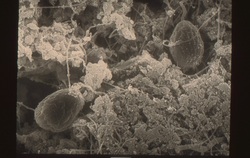
 Biofilms develop as microbial growth slows and the cells begin to excrete polymers that act like a glue between cells. The cells and other solids in the water begin to form a biofilm on surfaces (also called floc in suspended growth systems). Biofilms contain a relatively low percentage of "active" living microbes usually between 5 - 12% in wastewater with the remainder being dead cells, biopolymers, particulates, and other debris found in the water. When exposed to harsh conditions such as pH changes, toxic chemicals, or adverse temperatures; the biofilm acts to protect the microbes from harm. Only the top layers are killed in the by chemicals such as disinfectants. Wastewater treatment requires the effective formation of biofilms as they indicate proper BOD/COD removal and provide a means to remove suspended solids from the water flow. Loss of biofilm consistency and seeing free cells in the water column are the first indications of upset condition.
|
AuthorErik Rumbaugh has been involved in biological waste treatment for over 20 years. He has worked with industrial and municipal wastewater facilities to ensure optimal performance of their treatment systems. He is a founder of Aster Bio (www.asterbio.com) specializing in biological waste treatment. Click to set custom HTML
Archives
April 2024
|

 RSS Feed
RSS Feed